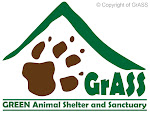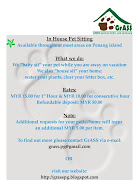GrASS's Product Video
For more information on our products please visit our product site: CLICK HERE
We Need YOUR HELP
Dear Friends,
The items are:
Scrap Paper
Old Newspapers
Old Magazines
Unwanted uncooked/raw Acidic Fruits ( Oranges, pineapples, lime,lemons)
Unwanted uncooked/raw fruits
Unwanted uncooked/raw Vegetables
Brown Sugar
Rice Bran
Red Earth
Glass Jars/Plastic containers with lids
Cardboard boxes (any other cardboard materials)
Aluminium Cans
Expired Food Products
We here at GrASS need your help to help us gather the below mentioned items to help us raise funds for our shelter and other independent pet rescuers.
The items are:
Scrap Paper
Old Newspapers
Old Magazines
Unwanted uncooked/raw Acidic Fruits ( Oranges, pineapples, lime,lemons)
Unwanted uncooked/raw fruits
Unwanted uncooked/raw Vegetables
Brown Sugar
Rice Bran
Red Earth
Glass Jars/Plastic containers with lids
Cardboard boxes (any other cardboard materials)
Aluminium Cans
Expired Food Products
For more ways on how or what items you can donate to help please visit HERE
Thursday, August 27, 2009
View: Zoo in bad condition
Thursday August 27, 2009
I CONCUR with S.M. Mohd Idris' view which appeared in The Star on Aug 25 that Zoo Negara should place more emphasis on the welfare of its animals. For years, complaints from disappointed visitors and outraged animal lovers have been met with the official response that once Zoo Negara receives funds, it would be able to upgrade its facilities and improve the living conditions of the animals.
Years have passed but the animals are still living in a squalor. Very little effort has been made to truly educate visitors on the animals' natural history or on animal welfare and wildlife conservation issues.
I am of the opinion that improving the quality of life of zoo animals need not be a costly exercise. The management of Zoo Negara could take basic steps such as the following:
> All washable substrates should be cleaned and disinfected regularly and rotting food and animal waste must be removed from non-washable substrates as quickly as possible for health, safety and aesthetic purposes.
> There should be proper drainage systems in the animal enclosures, and there should not be standing water in the enclosures after a heavy rain. I have noticed algae-infested enclosures and food and water receptacles at the zoo. This creates a risk of contamination of food and water, and of injury to animals and people due to slippery surfaces.
> All animal enclosures must be of sufficient size and complexity to allow the animals to display species-typical behaviour such as dust-bathing, climbing or roosting, and must have sufficient variety in the substrate and topography to allow the animals to withdraw from social interaction with other animals and humans if the need arises.
Furthermore, animal enclosures must not be overcrowded and must allow animals an opportunity for privacy. This is especially important in the petting section, as most of the animals there do not appear to enjoy being handled by humans.
The animals at Zoo Negara appear to have been mostly grouped together according to taxonomy, i.e. all primates, or all birds, as opposed to being grouped in ersatz environments that attempt to resemble the animals' natural habitats and social groups.
I have read media reports that enrichment programmes for animals are being carried out at the zoo but have yet to see evidence of this in action. The animals there look invariably bored, listless and lethargic. Enrichment programmes such as food puzzles that help develop natural hunting or foraging skills, and auditory and olfactory simulations that resemble what an animal may hear and smell back in its habitat, do not cost much but will be able to provide animals in captivity with mental and physical stimulation.
Since the moats at the zoo appear to be perpetually dirty, stagnant and foul-smelling, I would suggest filling up the moats and building solid walls with overhangs instead, to prevent escape and human-animal conflict. Viewing panels could be built into the walls, and some of them should be of appropriate size and strength to safely allow for photo opportunities.
This would eliminate the need for constant cleaning and filtration of the moats, create more land space in each enclosure and eliminate the problem of humans feeding junk to the animals or throwing things into their enclosures. The walls could be constructed to appear more naturalistic, for example, to resemble a bamboo grove or tree trunks.
To be successful, Zoo Negara needs to do far more than just expand its collection of animal exhibits. Its current strategy of adding animal exhibits without first attempting to reduce animal deaths simply defies science and common sense.
WONG EE LYNN,
Petaling Jaya.
This article was taken from: The Star Online: Opinion 27 August 2009
I CONCUR with S.M. Mohd Idris' view which appeared in The Star on Aug 25 that Zoo Negara should place more emphasis on the welfare of its animals. For years, complaints from disappointed visitors and outraged animal lovers have been met with the official response that once Zoo Negara receives funds, it would be able to upgrade its facilities and improve the living conditions of the animals.
Years have passed but the animals are still living in a squalor. Very little effort has been made to truly educate visitors on the animals' natural history or on animal welfare and wildlife conservation issues.
I am of the opinion that improving the quality of life of zoo animals need not be a costly exercise. The management of Zoo Negara could take basic steps such as the following:
> All washable substrates should be cleaned and disinfected regularly and rotting food and animal waste must be removed from non-washable substrates as quickly as possible for health, safety and aesthetic purposes.
> There should be proper drainage systems in the animal enclosures, and there should not be standing water in the enclosures after a heavy rain. I have noticed algae-infested enclosures and food and water receptacles at the zoo. This creates a risk of contamination of food and water, and of injury to animals and people due to slippery surfaces.
> All animal enclosures must be of sufficient size and complexity to allow the animals to display species-typical behaviour such as dust-bathing, climbing or roosting, and must have sufficient variety in the substrate and topography to allow the animals to withdraw from social interaction with other animals and humans if the need arises.
Furthermore, animal enclosures must not be overcrowded and must allow animals an opportunity for privacy. This is especially important in the petting section, as most of the animals there do not appear to enjoy being handled by humans.
The animals at Zoo Negara appear to have been mostly grouped together according to taxonomy, i.e. all primates, or all birds, as opposed to being grouped in ersatz environments that attempt to resemble the animals' natural habitats and social groups.
I have read media reports that enrichment programmes for animals are being carried out at the zoo but have yet to see evidence of this in action. The animals there look invariably bored, listless and lethargic. Enrichment programmes such as food puzzles that help develop natural hunting or foraging skills, and auditory and olfactory simulations that resemble what an animal may hear and smell back in its habitat, do not cost much but will be able to provide animals in captivity with mental and physical stimulation.
Since the moats at the zoo appear to be perpetually dirty, stagnant and foul-smelling, I would suggest filling up the moats and building solid walls with overhangs instead, to prevent escape and human-animal conflict. Viewing panels could be built into the walls, and some of them should be of appropriate size and strength to safely allow for photo opportunities.
This would eliminate the need for constant cleaning and filtration of the moats, create more land space in each enclosure and eliminate the problem of humans feeding junk to the animals or throwing things into their enclosures. The walls could be constructed to appear more naturalistic, for example, to resemble a bamboo grove or tree trunks.
To be successful, Zoo Negara needs to do far more than just expand its collection of animal exhibits. Its current strategy of adding animal exhibits without first attempting to reduce animal deaths simply defies science and common sense.
WONG EE LYNN,
Petaling Jaya.
This article was taken from: The Star Online: Opinion 27 August 2009
Subscribe to:
Post Comments (Atom)











No comments:
Post a Comment